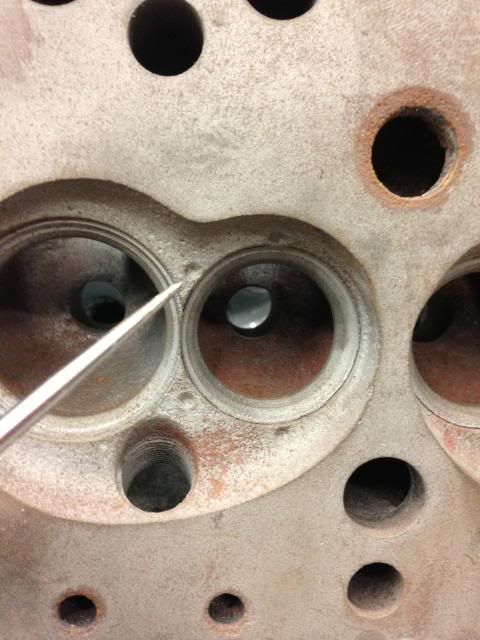
Hi everyone

Something that I thought I'd share with you that I seem to find a bit on heads (not just mini ones). This is a head that I had just started work on, and one of the exhaust inserts popped out of it. I was boring out the internal diameter to suit larger valves. When I do this on correctly installed seats, there is not issue. But ones that are dodgy installations sometimes move or pop out like this one. Obviously, machining an insert is never a good idea if you're going to be taking either huge cuts or reducing its thickness too much... if that’s what you need to do, then really, start from scratch and put a bigger insert in.
3 things that I think tend to be the issue are.....
1:- not enough interference
2:- people trying to install them with loctite
3:- people either chamfering the back or not putting a big enough radius on.
The correct interference for installing seats in cast iron heads is 0.004" per 1" of O.D ... or 0.1mm per 25.4mm So on the seats I tend to use which are 33.89mm in diameter, I use 0.13mm of interference.
How do we release loctite? We heat it up with a blow torch to break the bond. What happens to exhaust valve seats? They get bloody hot

so if you loctite them in, chances are, after the engine has been run for a bit, the loctite will release.
When you're pressing in an insert, or any part with interference, the part is going to need a "lead in" or a "leading edge" so that it will go in. Otherwise it either simply won't go in, or it will broach the hole as it goes in, increasing the diameter of the hole and decreasing the interference.

What I am pointing to in this photo is a 45 degree chamfered edge that was put there as a lead in. It will work, it will provide a lead in.. BUT.. it still has an edge on it where the 45 degree angle meets the large outside diameter. That edge can still broach the hole. The best option is a smooth radius. Below are photo's of two inserts, a genuine one with a TAM part number and an oversize one right, if you look carefully, both have a radius.

Another strange one that I have seen is people peening loose inserts in. Or peening them to make them hold more... or something....

Again, not a great idea... you're creating uneven tension around the insert. You can peen holes to decrease their size, but you can't really do it here successfully or accurately. Usually the best way is by placing a large ball bearing (at least 3 times the diameter of the hole) over the hole and striking it, making it shrink around the top edge. This is fine in applications where you "Just need interference and it doesn't matter how much"... however, on a head, you would neither be able to fit a ball bearing that size over the valve seat due to the small size of the combustion chamber nor would it be advised due to the potentially catastrophic consequences of it not having enough bite. Best way to do it is the right way.... make sure you machine the shoulder to the right size for the insert.
Alex





